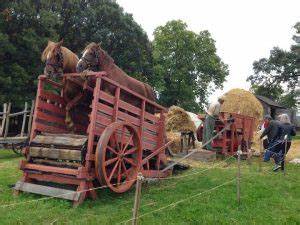 In 1849, Minnesota Territory was established with a population of fewer than 6,000 settlers. With few towns and a widely scattered population, farmers raised the food and most of the supplies for their own families, providing little for trade to stores or markets. As the territory grew, improved transportation routes and better farming techniques allowed farmers to supply food for new settlers and growing cities.
In 1849, Minnesota Territory was established with a population of fewer than 6,000 settlers. With few towns and a widely scattered population, farmers raised the food and most of the supplies for their own families, providing little for trade to stores or markets. As the territory grew, improved transportation routes and better farming techniques allowed farmers to supply food for new settlers and growing cities.
The National Grange purchased the Kelley farm in 1935 and donated it to the Minnesota Historical Society in 1961. At this National Historic Landmark, visitors become involved in living history demonstrations of the work and play of daily life for Oliver H. Kelley’s family and other farmers in mid-19th-century Minnesota. Join us at the farm and explore the following pages to learn more about Kelley, farm life and our tour programs. Throughout the year the National Grange Foundation collects donations from Subordinate/Community Granges and State Granges to support the Kelley Farm. During each National Grange Convention, the National Grange presents the Kelley Farm with one check. This check goes
Throughout the year the National Grange Foundation collects donations from Subordinate/Community Granges and State Granges to support the Kelley Farm. During each National Grange Convention, the National Grange presents the Kelley Farm with one check. This check goes along way in helping the Kelley Farm. The Kelley Farm also has representatives at the Convention to show off what the farm has done and what the upcoming projects will be. The donations to the Kelley Farm Foundation allow us to continue our support and help keep the Kelley Farm open for visitors and Grange members to learn not only about one of the founders of the Grange but to see how an 19th century farm was ran.
The Kelly Farm Fund is a dedicated fund, the income and principal may be spent for the dedicated purpose only.
[tx_button style=”default” text=”Donate to the Kelley Farm Fund” url=”https://www.paypal.com/cgi-bin/webscr?cmd=_s-xclick&hosted_button_id=NQAA5Z2QA2P4A” color=”#1a41a5″ textcolor=”#ffffff” target=”blank”]
